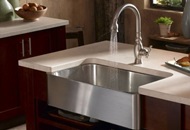Old sinks tend to become damaged or cracked. A lot of home owners make the decision of replacing kitchen, bathroom or even backyard sinks in London because they became broken or look old, in an attempt to redesign their homes.
Table of Contents
The procedure for replacing sinks described by our plumber in London
Acquiring new sinks and replacing old sinks in London can be a quite complex procedure, being very important to make sure that the current countertop fits the newly purchased sink first. Certain types of sinks, such as pedestal ones, might necessitate the entire removal of the current countertop.
For example, if you want to replace a molded-in sink or a self-rimming one with a specialty sink (these can be, for example, two bowl commercial prep ones, stainless steel hand sinks or wall mounted untility sinks), the current countertop might have to be removed before installing the new one.
When replacing a sink, it is important to ask for the assistance of a firm specialized in plumbing services in London.
How can plumbers near me install a new sink?
When installing a new sink, our plumbers in London take the following steps:
1. Checking if the new sink matches with the countertop hole. If the new sink is bigger, the countertop will be adjusted to the right dimension by using a jigsaw;
2. Attaching the clips inside the sink bowl;
3. Installing the faucet and the supplementary pieces;
4. A plumber in London applies a small amount of plumber’s putty around the drain strainer and he installs it;
5. The sink is tilted to its side to install and secure the rubber gaskets and threaded flange under the sink drain;
6. The excess putty is removed by using a cloth;
7. If there is a garbage disposal, the mounting bracket is installed with a screwdriver to the sink bottom;
8. A silicone bead sealant is applied on the edge of the basin;
9. The sink is installed into the countertop;
10. The supply lines are attached to the water pipes of the faucet and the supply lines;
11. If there is a garbage disposer, the unit is set up according to the manufacturer’s instructions;
12. The dishwasher drain is reinstalled;
13. The disposer discharge pipe is connected to the sink drain line and the P-trap is reattached;
14. Checking if the old drain pipe fits with the new sink. In case it does not, the drain pipe will be readjusted accordingly;
15. A small amount of sealant is applied on the edges of the sink;
16. Reconnecting the power to the disposer;
17. The water is turned back on and our local plumber will check if there are any leaks.
Sink materials in London
When replacing a sink, our plumbers in London recommend you to consider the different materials they are made of and the benefits which these materials can involve. Generally, there are four types of sink materials:
1. Stainless steel: usually utilized for kitchen sinks, because it is affordable and resistant. This type of material does not get damaged by hot or cold objects/liquids, being difficult to get stained. On the downside, these types of sinks have the tendency to scratch easily and present water spots;
2. Porcelain or enamel-over cast iron: it is another material generally used for kitchen sinks. It can have different colors, styles and shapes. It can endure cold or hot water, however might get broken at the impact with heavy objects. Besides, the enamel or porcelain can get damaged, causing the rusting of the exposed cast iron;
3. Composite materials: these are materials made of crushed granite or quartz in combination with a resin filler. They are recommended by our plumber in London as they are extremely resistant to scratches and stains;
4. Fireclay or ceramic: normally more durable than cast iron sinks, being also more expensive.
If you want to replace your sink in London, we are here to help. We invite you to contact our emergency plumber in London for immediate assistance.

